Through the lens of our nation’s most storied lands and some of the iconic places preserved by the National Park Service, “Twenty & Odd” builds on the innumerable contributions of African Americans to the foundation of the United States. Developed by a group of NPS staff and interns—mostly young African American women—and set against 400 years of suffering, healing, and strength, the film explores the trauma, resilience, and beauty of the African American experience in our country.
In this companion to the video, the creative team shares its approach and choices for the scenes, locations, and history. Together, the film and the companion guide serve as an opportunity to educate, motivate, and empower people from all walks of life to adopt and maintain healthy lifestyle behaviors, cultivate personal connections with national parks and embrace parks as welcoming sources of health and healing.
The narration and inspiration for the film is Dr. Maya Angelou’s “Still I Rise” read by the poet herself…
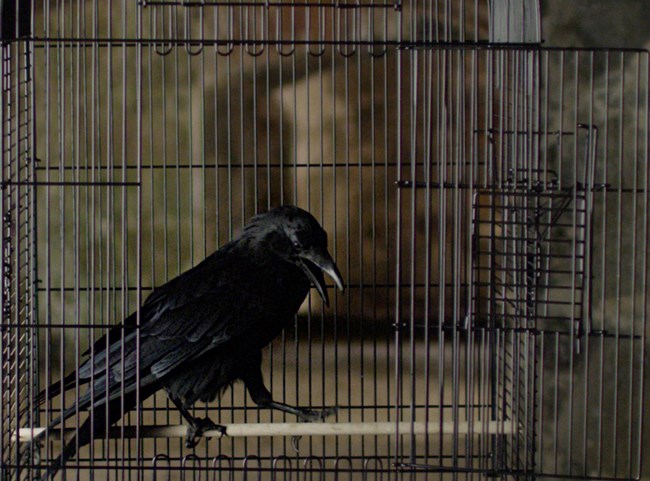
Caged Bird
The opening moments of “Twenty & Odd” begin with the audio of Maya Angelou’s poem, “Still I Rise.” This scene, filmed at the Casemate Museum at Fort Monroe National Monument, sheds light on the human impact of slavery. The shot features a black bird—a raven—that remains in a cage despite the caged door being open. This represents the institution of slavery and its physical, mental, and social impacts, paving the way for generational trauma and effects which are still felt today. This scene is also symbolic of African American potential to achieve greatness that, for many, is not realized due to socialized feelings of inferiority.
Fort Monroe National Monument is the location where enslaved Africans were first brought to English-occupied North America. English colonist John Rolfe was the first to document this monumental event by describing how the ship “brought not anything but 20 and odd Negros, which the Governor and Cape Merchant bought for victualls,” hence the title of the film, "Twenty & Odd." In addition, this scene honors Maya Angelou and her first autobiography, I Know Why the Caged Bird Sings.
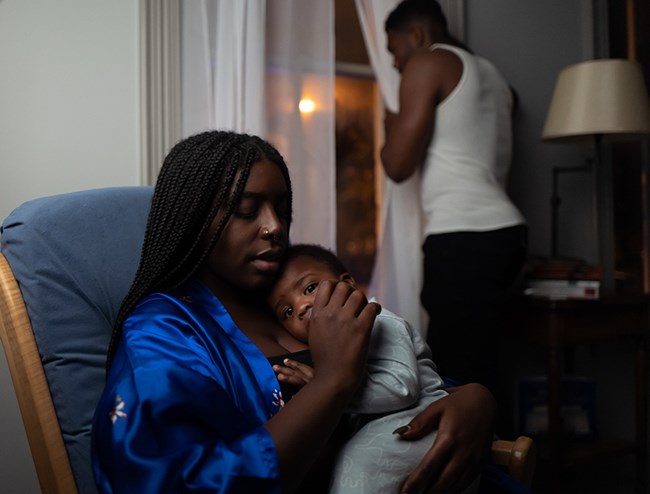
Family
Everyone in the world has gone to bed
One night or another with fear
Or pain or loss
Or disappointment
And yet each of us has awaken, arisen
Somehow made our ablution
The theme of the African American family (mother, father, baby) is portrayed in the opening scene. Our cultural experiences, research and social structure have taught us that family is the foundation, and the strength of the African American community. The leadership and guidance of our mothers, fathers, grandparents, and extended family are all essential to how we begin to develop our self-perspective, outline the way in which we socialize with others and shape how we view the world. Often, strong family units are not represented within the mainstream media. It was important that the film lead with a strong depiction of mother and father caring for their young.
This shot was filmed at the Carter G. Woodson Home National Historic Site. In 1915, Woodson founded the Association for the Study of Negro Life and History, now the Association for the Study of African American Life and History (ASALH), and is regarded as the father of African American history. Today ASALH partners with the National Park Service in the care of Carter G. Woodson site and telling African American stories across the National Park System.
The subject of police brutality is touched on subtly when the father looks out of the window at the flashing police lights. This imagery signifies not only the pervasive fear and legacy of historical police brutality, but also serves to highlight the desire of many black men to fulfill their role as parent and protector of the family while living in a contemporary climate where there are frequent incidents of unarmed African American men being killed by police.
This scene is also coupled with the innocence of black youth. Though the opening lines of the poem discuss feelings of fear, pain, and loss, Maya Angelou then transitions with hope by expressing, “And yet each of us have awaken, arisen.'' These lines feature the baby in his crib looking up in awe and wonder at his mother and father. To reinforce the importance and beauty of the black father and son relationship, we included a scene where the father is bathing his baby boy in a sink. Placing the child in the sink recognizes the tradition of washing young babies in the sink when they are young. Notice that in the opening scene the father is seen with a look of distress with worry about the outside world, while in the second scene he is in the comfort of his home, full of happiness while engaging in the joyful laughter and glee of his son.
The bath scene also represents Dr. Angelou’s reference to “ablution,” which is the cleansing of oneself.
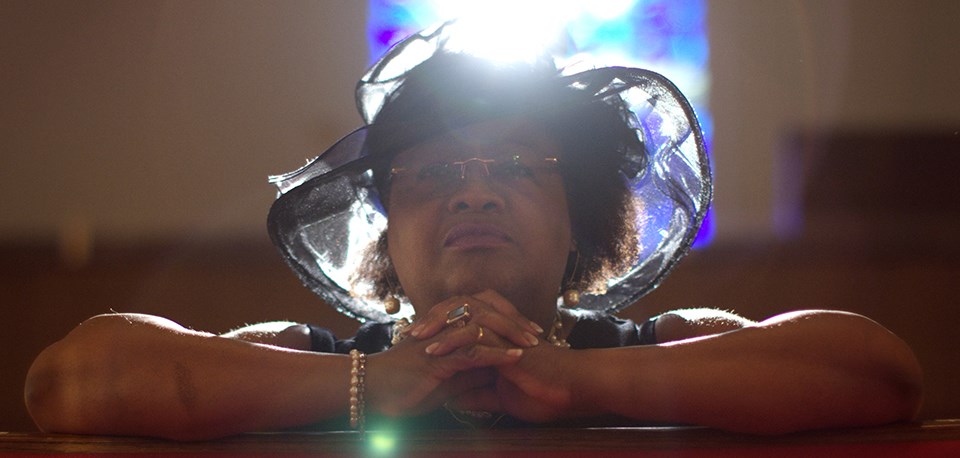
Spirituality
Wherever there abides in the human being
There is the nobleness of the human spirit
Despite it all
We rise
This scene was filmed at the 16th Street Baptist Church in Birmingham, Alabama, where four young African American girls and two young boys were killed in a racially motivated bombing in 1963. Along with the significance of this tragic moment in history, the church represents an important facet of the African American community. Church is a place where people come together to congregate and worship. For many African Americans, it is a place of welcoming solace and a site of resistance to racism, which frequently made the black church a target of violence by white supremacists as evidenced by the 16th Street Baptist Church bombing.
In this scene, a woman is featured bowing her head in prayer in a church pew, and then slowly lifting her head as the angelic glow of sunlight streams through the stained glass windows of the church. This woman is Lisa McNair, the sister of Denise McNair, one of the four girls killed in the bombing. The 16th Street Baptist Church is a National Historic Landmark and is an important place within the larger Birmingham Civil Rights National Monument, which was added to the African American Civil Rights Network in 2019.
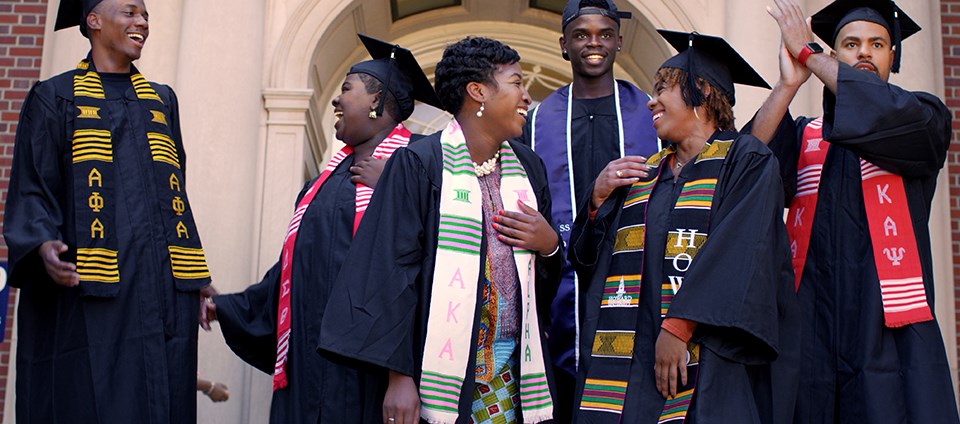
Education
You may write me down in history
With your bitter, twisted lies
This scene was filmed at Founders Library on the campus of Howard University in Washington, DC, a Historically Black College and University (HBCU) founded in 1867 by missionaries as a training facility for black preachers. It was decided that the school would be named after Civil War hero General Oliver O. Howard, a white man who served as the Commissioner of the Freedman’s Bureau and the university’s first president. The bureau, which was founded in 1865, was a US government agency that aided freed blacks. Howard University would see to the education of 150,000 formerly enslaved people by 1872. Founders Library is the leading research library and archive on African American history and culture. Howard alumni and current students are shown standing in black caps and gowns with various types of stoles. Some of the participants are members of Greek organizations and represent their sororities and fraternities with their stoles. Other participants wore blue and white stoles, Howard’s school colors, or Kente cloth, which is significant in the African American community. Kente cloth originates with the Ashanti people in Ghana. It is common, especially among HBCU students, to wear this type of stole on the day of their graduation as a sign of the global African diaspora.
This scene correlates with this particular line of Maya Angelou’s poem to highlight black excellence. During the years of US slavery, most African Americans were legally barred from receiving any form of education and were unable to document their history in their own words. Along with other HBCUs, Howard University is a college that was founded to provide newly emancipated African Americans with a place where they could receive higher education. Focused not only on undergraduate studies, Howard offered pharmacy, law, medical, and dental education, and currently has 13 schools and colleges. Our portrayal of Howard University alumni and students standing together in graduation gowns reinforces the motivating message that African Americans are intellectually strong and education is valued within the community.
But just like life
I rise
During the Civil War, thousands of enslaved African Americans acquired their freedom after escaping to Union lines. Many were eager to obtain an education, and one of the first classrooms for newly freed men and women was under the Emancipation Oak tree—these classrooms were a precursor to Hampton University, an HBCU. The Emancipation Oak is also the location of one of the first southern readings of President Abraham Lincoln’s Emancipation Proclamation.
For this scene, a young mother sits on a blanket reading to her child in front of the tree. This highlights how important education is even at a very young age. Though the baby cannot completely understand the words yet, her mother is providing her with the tools of knowledge and laying an early foundation. For two and a half centuries after the first Africans were brought to the English colonies in North America, African Americans were beaten or killed for attempting to educate themselves. This simple scene of a mother bringing a book to the Emancipation Oak to read to her child signifies how far African Americans have come in history.
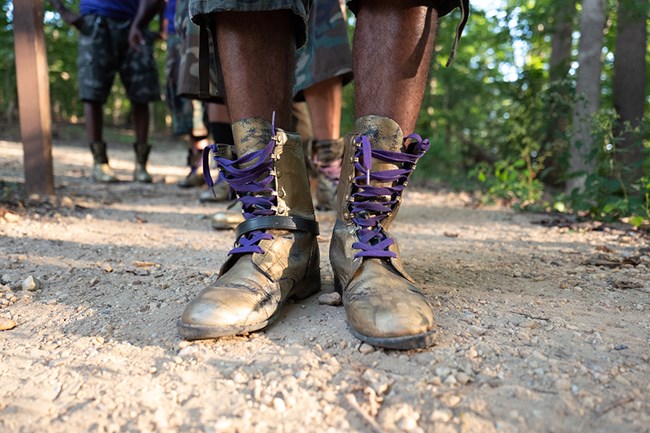
Cultural Expression
Greek Life
You may trod me in the very dirt
But still, like dust
I rise
Black Greek Letter Organizations (BGLOs), also known as “The Divine Nine,” are rich in African American history. Derived from the injustices and prejudices that many black people had to experience, BGLOs came into existence in the early 20th century. Often excluded or ostracized from joining other social groups on integrated college campuses, African American students initially attempted to create intercollegiate BGLOs, but were unable to maintain a consistent membership.
The first successful Divine Nine organization, Alpha Phi Alpha Fraternity, Inc., was established in 1906 at Cornell University. Other black fraternities and sororities continued to form afterwards including Alpha Kappa Alpha Sorority, Inc. (1908) at Howard University, Kappa Alpha Psi Fraternity, Inc. (1911) at Indiana University, Omega Psi Phi Fraternity, Inc. (1911) at Howard University, Delta Sigma Theta Sorority, Inc. (1913) at Howard University, Phi Beta Sigma Fraternity, Inc. (1914) at Howard University, Zeta Phi Beta Sorority, Inc. (1920) at Howard University, Sigma Gamma Rho Sorority, Inc. (1922) at Butler University, with Iota Phi Theta Fraternity, Inc. (1963) completing the Divine Nine at Morgan State University.
Though each BGLO may have different founding principles, they all have as their foundation the doctrines of community service, leadership, scholarship, and strong bonds of brotherhood and sisterhood. In addition, the Divine Nine serves as a method to culturally express black excellence. BGLO identifiers include colors, poses, symbols, greetings, clothing, strolling, and step routines. Strolling and stepping are distinct synchronized movements performed by members of BGLO either to music or in combination with chants.
This scene specifically features members of Omega Psi Phi Fraternity, Incorporated stepping and “hopping” on a park trail in Rock Creek Park, the third oldest national park in the United States.
Aesthetically, this scene showcases the standard gold boots that Omegas wear. They are shown kicking up dust on the trail to align with the quote in Maya Angelou’s poem, “But still, like dust, I rise.” Historically, the gold boots symbolize the horseback ride of Colonel Charles Young, a pioneer military, diplomat, and civil rights leader, who was a member of Omega Psi Phi, Inc. As commander of a famed African American Buffalo Soldiers unit, he traveled from Wilberforce, Ohio, to Washington, DC, to prove to the US Army that he was fit for active duty. The gold boots mirror the dust on his boots from the journey. Additionally, and importantly, Colonel Young was the first African American superintendent of a national park (Sequoia & Kings Canyon National Parks) and his many accomplishments are commemorated at the Charles Young Buffalo Soldiers National Monument in Wilberforce. Omega Psi Phi Fraternity, Inc. is also a philanthropic partner of the National Park Service.
Black Hair
Does my sassiness upset you?
Why are you best wtih gloom?
Just 'cause I walk...
Hair is a major component in the lives of African American women. From locs to braids, curly to straight, or an afro, hair is a major component of cultural expression for black women. The first part of this scene features a black-owned beauty salon on historic U Street in northwest Washington, DC. A young woman is pictured getting her locs retwisted by a stylist. The scene then pans to the two women walking towards the African American Civil War Memorial. One is the previously shown girl from the salon, and she does an elaborate hair flip of her bright golden locs. The other young woman has her natural hair pulled back in a long ponytail.
Historically, and in some places today, it has been seen as unprofessional for black women to wear natural or culturally-expressive hair styles in conventional corporate settings. One of the goals of this scene is to show the various aspects of beauty in all types of styles, and to present a visual portrayal for African American women truly embracing their ethnicity and natural state of being.
Black Women
Does my sassiness upset you?
Don't take it so hard just 'cause I laugh
Along with hairstyles, African American women culturally express themselves in various other forms. Big hoops, extravagant nails, body piercings, and cultural tattoos are some of the ways that black women showcase their beauty. Cultural trends that may be seen as “ghetto” or low class are frequently reproduced as “high fashion” later on. This scene serves to reclaim the blackness of ethnic trends.
In this scene, a group of young black women of all different sizes and skin tones laugh together on the steps in Meridian Hill Park, a unit of Rock Creek Park and the National Park System. There are so many types of African American women, and this moment showcases the wide range of beauty that exists within the black community.
Meridian Hill Park, also known as Malcolm X Park, has a strong connection to the African American community. Mary Foote Henderson, wife of a post-Civil War US senator, had the original vision for the Italian Renaissance style of the park. In order to accomplish her goal, Henderson convinced Congress to create the park, evicting the working-class African American residents of that community. The official opening of Meridian Hill Park was in 1936. However, by 1960 the park had become the unofficial meeting grounds for many black activists. In 1969, Professor Angela Davis called for action to rename the park after Malcom X, a request that was supported by many others in the African American community. This congressional measure failed in 1970, but by this point the name “Malcolm X Park” had become common and it continues to be used by many DC residents today.
Black Men
As if I have gold mines
Digging in my own backyard
In this scene, a group of young black men in business suits lean on a 1969 Chevrolet Impala in front of Dr. Martin Luther King, Jr.’s birth home, now part of Martin Luther King, Jr. National Historical Park. They are all dressed professionally, and though it is not shown in this particular scene, one of the young men has a grill in his mouth. It is subtly showcased later in the film when he is laughing. Even while appearing digestible enough for corporate America, this idea behind this scene is a look towards a future where young black men are able to express themselves via clothes, hair, shoes, and other accessories the way that they wish without being stereotyped.
The original intent of this scene was to correlate with Dr. Angelou’s usage of the phrase “gold mines,” represented by the young men themselves, conveying that the gold to which Dr. Angelou refers is the immeasurable value of human life itself.
You can kill me with your hatefulness
Harpers Ferry was the location of an historic raid led by American abolitionist John Brown in 1859. Brown and his band overran a federal arsenal as the first step in a detailed plan to create an independent stronghold of freed slaves in Virginia and Maryland. Though Brown was captured and executed for treason, his incursion enraged white Southerners, deepening the sectional tensions between the North and South that contributed to the start of the Civil War.
In this scene, five black males of varying ages stare into the camera. Similar to the seriousness portrayed in the scene at Martin Luther King, Jr. National Historical Park, the solemnity portrayed in their facial expressions corresponds with this line of Angelou’s poem. Black men were weakened physically and mentally by enslavement, were lynched without reason during the Jim Crow era, and are incarcerated and killed the most frequently by law enforcement currently. The scene includes adult men, teenagers, and a young boy. The ranging scope of ages provides a generational visual.
Music
Shoulders falling down like teardrops
Weakened by my soulful cries?
For centuries, music has been essential to the African American community. During slavery, music provided an outlet for African Americans to express their emotions. Negro spirituals, songs that combined African culture and religion, were passed down through generations. Throughout the years, African Americans have been both the originators and major influencers of many genres such as hip hop, R&B, gospel, reggae, blues, and jazz.
In this scene, a man is featured playing his trumpet in the rain. Jazz is a genre of music that originated in New Orleans and is still prevalent in the city’s culture today. The man is staring directly at the camera while the raindrops are hitting him, and though the audio is not heard in the video, he produces beautiful music with his trumpet. This is symbolic of how enslaved Africans were forced to deal with extremely adverse conditions, but still found a way to create songs and find solace in the comfort of their music.
Legacy
...as if I have oil wells
Pumping in my living room
Maggie Lena Walker was an African American social activist, businesswoman, and teacher. In 1903, Walker also became the first woman in the United States to charter a bank and serve as bank president. Living during the Jim Crow era, Walker overcame social, racial, and economic boundaries to reach her accomplishments and empower others. Through her civil rights activism and unwavering determination, she was a pillar and an inspiration for the African American community.
Walker was very close to her family and expanded her home to include 28 rooms to accommodate them. Residents of Walker’s home included her husband, mother, two sons, two daughters-in-law, four grandchildren, adopted daughter, son-in-law, and chauffeur. Maggie L. Walker National Historic Site, her home and a unit of the National Park System, shares her story because her family continued to preserve her legacy after her death in 1934.
This scene portrays an elderly couple sitting in chairs in one of the living rooms in Walker’s home. The original idea was to include a wall or mantel of pictures of children, grandchildren, and great-grandchildren to represent the couple’s legacy. Oil wells are a representation of wealth and prosperity, and the “oil wells pumping in my living room” could also be symbolic of the richness in family.
Just like hopes springing high
Still I rise
The Edmund Pettus Bridge along the Selma to Montgomery National Historic Trail is a significant icon of the African American civil rights movement. Here on March 7, 1965, voting rights marchers led by civil rights activist John Lewis were violently challenged by law enforcement, marking the day in history as “Bloody Sunday.” In this scene, Joanne Bland and her granddaughter are featured standing on the bridge holding hands. Joanne Bland participated in this historic march when she was 11 years old with her parents. Bland specifically requested that her granddaughter be in this scene alongside her, portraying her continued legacy. They are both wearing red to honor those that were killed or injured in connection with the Bloody Sunday march.
Recreation
With the certainty of tides
In this scene, a father and son are featured walking by the water at Anacostia Park with a fishing rod.
Did you want to see me broken?
Bowed head and lowered eyes?
In this scene, a father holds his young daughter up while helping her skate at the Anacostia skating rink. The daughter is concentrating on her feet and has her head bowed, and then slowly lifts it as she realizes that she can trust the strength of her father.

Intersectionality
You can shoot me with your words
You can cut me with your lies
To explore intersectionality, all types of African American people were represented in this film. This scene shows a group of African American models that are a part of the lesbian, gay, and bisexual (LGB) community outside of the Stonewall National Monument. Everyone is in outfits they feel comfortable wearing and it includes a wide range, from a woman sporting a bowtie to a man in a James Baldwin shirt. (James Baldwin was a gay African American writer, activist, playwright, and an advocate for people loving whomever they want.)
Stonewall National Monument is a paramount part of the LGB community. In June 1969, a groundbreaking demonstration occurred at this location. During this time, New York City had harsh prohibitions against homosexual activities. Police raids were common for bars or restaurants that served anyone that identified as gay. During a raid at the Stonewall Inn, instead of allowing police to simply arrest them, an agitated crowd took a stand against them. They formed a blockade by linking arms while the police tried to charge through them. This rebellion was a spark of the fight for equal rights for the LGB community. In the scene, the cast is all connected and lightly touching each other in front of the Stonewall Monument to portray their union and solidarity. This scene is particularly important given the discrimination that the African American women who identify as LGB people face within society as well as their own communities.
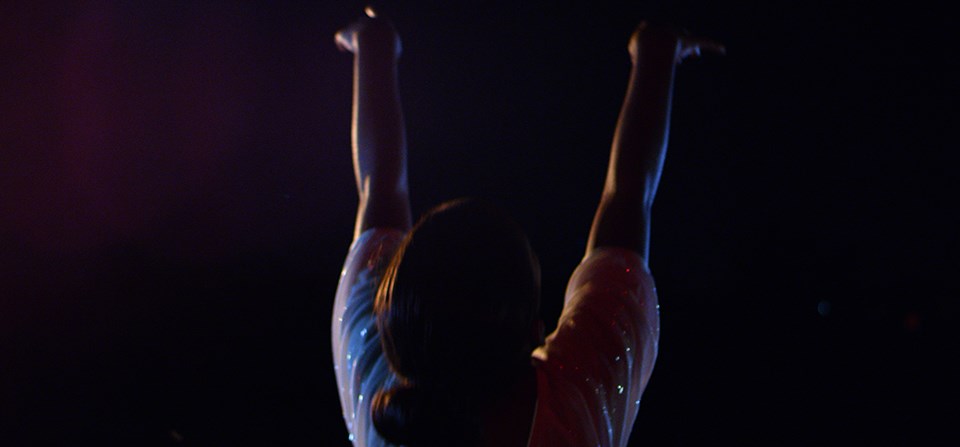
Resilience
Aw, does it come as a surprise
That I dance as if I had diamonds
At the meeting of my thighs?
While Monocacy National Battlefield is best known for its Civil War history, in 2003 the remains of a 200-year-old slave population was found near the Best Family Farm site within the park. The farm was built by a French Caribbean family in the 1790s and was home to about 90 enslaved African Americans. The National Park Service has been working to excavate the slave quarters and study the site’s history.
In this scene, a young ballerina dances on the grounds of the Monocacy National Battlefield during the nighttime. Coupled with the dark setting, there is a spotlight that shines down on her while she is dancing. The light symbolizes the souls of the enslaved population beaming on her. During her improv dance, she moves within the light in a portrayal of homage to these ancestors.
The ballerina signifies innocence and hope contrasted with a setting that is tethered to pain and suffering. Despite a dark history, African Americans have exemplified strength and continue to strive for the light. The nighttime setting paired with bright, white lights shows that even in the face of darkness, African Americans have the resilience to keep searching and staying in their light. In the way that ballerinas are known for having superb posture and graceful movement, African Americans have moved through grief with grace and poise.
Out of the huts of history’s shame
I rise
Despite discrimination, African Americans have been an instrumental part of US military history. For years, black soldiers were denied military leadership roles or combat training because it was assumed that they lacked the ability or qualifications.
Before 1940, African Americans were not allowed to fly for the US military. With the help of continued pressure from the black press and civil rights organizations, the 99th Pursuit Squadron of African American soldiers was formed in 1941. Trained at Tuskegee, Alabama, these men were known as the Tuskegee Airmen.
This team was taught aviation and proper maintenance of combat aircraft by the Army Air Corps program. Tuskegee Airmen incorporated many roles including pilots, bombardiers, navigators, instructors, and support staff. Regardless of prejudice and segregation, the Tuskegee Airmen became one of the most respected groups to fight in World War II. They exceeded expectations and paved the way for full African American integration into the US military. In this scene, a young man in a Tuskegee Airman suit is featured walking out from the dark as doors open into the light, symbolizing the resilience of the Tuskegee Airmen and how they ultimately achieved greatness.
Innocence
Up from a past rooted in pain
I rise
The African Burial Ground is the largest and oldest-known burial ground of enslaved and free African Americans. It was not discovered until 1991 during the development of the site for a 34-story federal office building at 290 Broadway. Federally funded construction projects require a review of impacts to significant archeological or cultural sites. Preliminary archaeological research excavation found intact human skeletal remains located 30 feet below the city’s street level on Broadway. This discovery greatly impacted and updated the narrative and history of the contributions that African Americans made towards the foundation and construction of the city.
In this scene, we feature Iam Moore, the four-year-old son of one of the creative team members. Iam is shown slowly walking and touching the walls at the African Burial Ground. His face is full of awe and contemplation as he looks at the Adinkra symbols. Adinkra is a cotton cloth made in Cote d’Ivoire and Ghana. Adinkra symbols express popular concepts, record historical events, portray attitudes and feelings, and represent well-known proverbs. Iam touches an Adinkra symbol called Nkisi Sarabunda or Signature of the Spirit representing the Congo-Angolan belief that the spiritual and material world were inherently intertwined. This scene is symbolic of this perceived connection between the living and the dead. Without fully knowing the horrors of slavery, Iam’s eyes shine with wonder and admiration as he walks on top of the foundation of where his ancestors were buried.
Remembrance
A black ocean, leaping and wide
Welling and swelling
I bear in the tide
The first enslaved Africans were brought to the shores of what is now Fort Monroe National Monument. The first documentation of this event, written by English colonist John Rolfe, counted them as “20 and odd Negroes.” This phrasing portrays how insignificant their lives were to the colonists in Virginia. In this scene, and with the title of this film, we want to honor those first enslaved Africans, and all of the other enslaved that were brought after them. We want to remember those that died due to the terrible conditions during the Middle Passage, and those that survived but had to endure a devastating life enslaved and delegitimized.
This scene features the five creative writers of this film walking on the sand and through the water at Fort Monroe. Our faces are introspective and solemn as we respectfully reflect on the experiences of our enslaved ancestors, the atrocities they faced, and honor the continued resilience of African American life and history.
Regarding the film, Maya Angelou’s phrase, “a black ocean,” signifies the darkness that arriving at those shores meant for the enslaved Africans. Her words, “I bear in the tide”, indicates how strong these enslaved people were in such devastating circumstances, and how we will continue to be strong in remembrance of our ancestors.
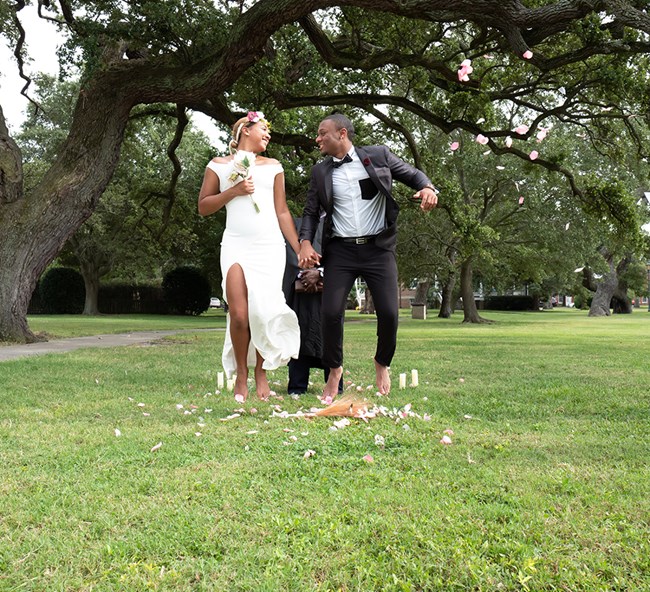
Union
Marriage
Leaving behind nights of terror and fear
I rise
Into a daybreak miraculously clear
The Witness Tree, or the Algernourne Oak, is not only a majestic part of nature, but also a living witness to the history of the first enslaved Africans. Planted at Fort Monroe, this tree has been around long enough to witness the arrival of the first African Americans in 1619.
This scene depicts the ceremonial union of a young black couple. Along with the beauty of the setting and the decorations, there is an ornamented broom. In many African American weddings, it is a tradition to “jump the broom” after the exchanging of vows. This tradition stems from the legacy of slavery. A union between two enslaved African Americans was not typically recognized as legal or official, so the bride and groom would legitimize their romantic unions in the enslaved community by jumping the broom. The veracity of this tradition remains dubious among scholars of folklore and African American history. Jumping the broom has a number of meanings and origins. According to some scholars, rather than being a traditional rite of passage carried over from the African continent, jumping the broom was a ritual tradition of European origin and was something of a parlor game expected of the enslaved during wedding ceremonies slaveholders held for them. Nevertheless, many contemporary African American weddings continue to feature this tradition in order to honor our enslaved ancestors by participating in this act.
With the many hardships that the Witness Tree has seen, we wanted to contrast this with a scene featuring love and happiness.
Communal Gatherings
I rise
Bringing the gifts that my ancestors gave
I am the hope and the dream of a slave
This scene showcases community in a more formal setting at the home of Frederick Douglass. It portrays African Americans of all ages dressed in white attire coming together to eat at a lavishly set outdoor dinner table. In black communities, all-white affairs are popular, especially in the warmer seasons. This scene shows how African Americans are now able to have a seat at the table, literally and metaphorically.
The guests featured at the table are some of the film’s stakeholders, historic National Park Service figures, and family and friends of the creative team. We feature Robert Stanton, the first African American director of the National Park Service, and Fleur Paysor, media relations manager at the National African American Museum of History and Culture, as the patriarch and matriarch of the table.
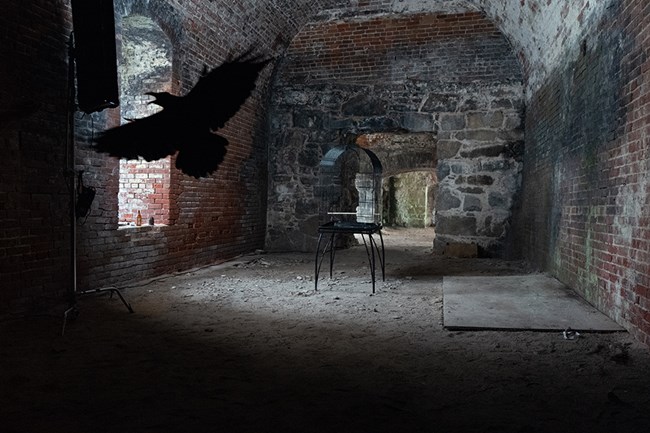
Liberation
And so, naturally
There I go rising
The closing scene of “Twenty & Odd” returns to the location of the first scene. Again, we see the black raven sitting in an open cage at the Casemate Museum at Fort Monroe National Monument. However, we show the bird finally flying out of the cage. The timeline placement of the opening and concluding scene underscores the overarching idea of the film. In remembrance and honor of the long history of trauma that African Americans have endured, the roadblocks that have been faced, and the current issues that still exist, we depict the raven feeling limited in its cage without hope of leaving it. In contrast, the raven flying out of the cage at the end of the film symbolizes strength in the face of adversity, struggles that have been overcome, mountains that have been climbed, dreams that have become reality, and the magnitude of black excellence overall. The liberated bird shows how far African Americans have risen, and how they will continue to rise.
“Still I Rise” by Dr. Maya Angelou
Used with permission of Caged Bird Legacy, LLC
Cast and Crew
The “Twenty & Odd” video was made with the support of many people on the cast and crew, including many donating their time and talents. Below is a list of many of the people involved in the production of the video.
Producers: Christian Bacon, Kayla Diallo, Kayla Hall, Ridasian Moore, Subria Spencer, and Rhea Warren
Directors of Photography: Will Pattiz and Jim Pattiz
Photographer: Tony Mobley
Michael Adams
Christopher Allen
Cole Austin
Tamahni Baltimore
Cody Bass
Laman Baylor
Christian Beacon
JoAnne Bland
Jasmyn Bowie
Trey Bryant
Christina Crump
Katrina Crump
Chloe Davis
Cornemah Day
Corneyah Day
Kayla Diallo
RasErin Dickens
Porsha Dossie
Kelly Downing
Chad Franklin
Kwenton Gaines
Kyle Garrison
Kendra Givens
Joyvonte Grant
Kayla Hall
Jordan Hyatt
Khadijah Ishaq
David Jackson
Cameron Jones
Demetrius Jones
Ronnae Kemper
Olubukunola Kolawole
Yannick Lungu
Joslin Massenborg
Lisa McNair
Angela Miles
Arri Miles
Marvin Miller
Nicole Miller
Ridasian Moore
Yvonne Newsome
Rachel Palmer
James Parker
Fleur Paysour
Nigel Peterson
Kevin Poplar
Thaddeus Price
Marian Rosario
Dedrik Shafer
Tre Shafer
Kaila Rose Smith
William Spain
Jamelle Sparrow
Subria Spencer
Robert Stanton
Derrick Thurnton
Imani Viney
Nasir Akeem Wah
Keanee Walker
Rhea Warren
Airiye We-kandodis
Osei White
Curtis Williams
Last updated: February 14, 2025
